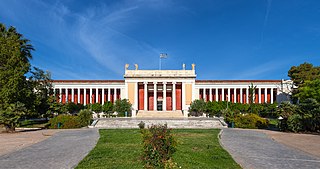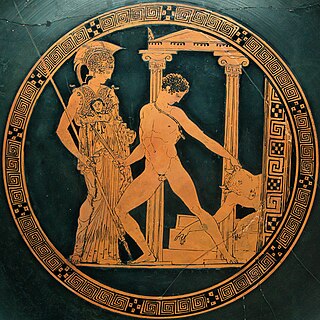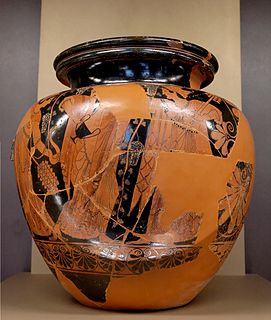
Ancient Greek pottery, due to its relative durability, comprises a large part of the archaeological record of ancient Greece, and since there is so much of it, it has exerted a disproportionately large influence on our understanding of Greek society. The shards of pots discarded or buried in the 1st millennium BC are still the best guide available to understand the customary life and mind of the ancient Greeks. There were several vessels produced locally for everyday and kitchen use, yet finer pottery from regions such as Attica was imported by other civilizations throughout the Mediterranean, such as the Etruscans in Italy. There were a multitude of specific regional varieties, such as the South Italian ancient Greek pottery.

Exekias was an ancient Greek vase painter and potter who was active in Athens between roughly 545 BC and 530 BC. Exekias worked mainly in the black-figure technique, which involved the painting of scenes using a clay slip that fired to black, with details created through incision. Exekias is regarded by art historians as an artistic visionary whose masterful use of incision and psychologically sensitive compositions mark him as one of the greatest of all Attic vase painters. The Andokides painter and the Lysippides Painter are thought to have been students of Exekias.

Red-figure vase painting is one of the most important styles of figural Greek vase painting.
The Kleophon Painter is the name given to an anonymous Athenian vase painter in the red-figure style who flourished in the mid-to-late 5th century BC. He is thus named because one of the works attributed to him bears an inscription in praise of a youth named "Kleophon". He appears to have been originally from the workshop of Polygnotos, and in turn to have taught the so-called Dinos Painter. Three vases suggest a collaboration with the Achilles Painter, while a number of black-figure works have also been attributed to him by some scholars.

The Kleophrades Painter is the name given to the anonymous red-figure Athenian vase painter, who was active from approximately 510–470 BC and whose work, considered amongst the finest of the red-figure style, is identified by its stylistic traits.

The National Archaeological Museum in Athens houses some of the most important artifacts from a variety of archaeological locations around Greece from prehistory to late antiquity. It is considered one of the greatest museums in the world and contains the richest collection of Greek Antiquity artifacts worldwide. It is situated in the Exarcheia area in central Athens between Epirus Street, Bouboulinas Street and Tositsas Street while its entrance is on the Patission Street adjacent to the historical building of the Athens Polytechnic university.

Nikosthenes was a potter of Greek black- and red-figure pottery in the time window 550–510 BC. He signed as the potter on over 120 black-figure vases, but only nine red-figure. Most of his vases were painted by someone else, called Painter N. Beazley considers the painting "slovenly and dissolute;" that is, not of high quality. In addition, he is thought to have worked with the painters Anakles, Oltos, Lydos and Epiktetos. Six's technique is believed to have been invented in Nikosthenes' workshop, possibly by Nikosthenes himself, around 530 BC. He is considered transitional between black-figure and red-figure pottery.

The Affecter was an Attic black-figure vase painter, active in Athens around 550 to 530 BCE.

The Antimenes Painter was an Attic vase painter of the black-figure style, active between circa 530 and 510 BC.

The Kerch style, also referred to as Kerch vases, is an archaeological term describing vases from the final phase of Attic red-figure pottery production. Their exact chronology remains problematic, but they are generally assumed to have been produced roughly between 375 and 330/20 BC. The style is characterized by slender mannered figures and a polychromatism given to it by the use of white paint and gilding.
The Acheloos Painter, active around 525–500 BCE in Athens, was a vase painter of the black-figure style. His scenes were like those of the Leagros Group; however, unlike their work, his themes are comic episodes, like modern cartoons. Herakles was a favorite topic, as were banqueting scenes. His banqueters were portrayed satirically: overweight, aging, huge, jutting noses, and so on. The heroic is made anti-heroic by parody. His preferred vase forms are amphorae and hydriae.

Aison was an ancient Greek vase painter of the red-figure style. About 60 of his vases survive, which are dated between 435 and 415 BCE. Aison spent his career in several workshops, where he came into contact with several other well-known painters. His first works were created in the same workshop as the Kodros Painter. A kylix with motifs from the Theseus legend, that is today in the National Archaeological Museum of Spain, was created in the same workshop that Penthesilea Painter was active in and Aristophanes was later to join. In his third workshop he worked together with the Schuvalow Painter and the Eretria Painter. Here he painted mostly closed containers. All three artists stood in the tradition of Polygnotos. From this time his second showpiece originates, the lekythos in Naples National Archaeological Museum. Two further lekythos clearly mark a turning point in the artist's life when he embraced the Adonis cult. The difference is seen in the quality of his work, which is probably due primarily to difficult life circumstances, as demonstrated by the frequent workshop changes.

Smikros was an ancient Greek vase painter who flourished in Athens between 510 and 500 BCE. He was active in the workshop of the Euphronios. Beside Euphronios, Euthymides, Hypsis and the Dikaios painter, Smikros was one of the most important representatives of the so-called Pioneer Group of Athenian red figure vase painting.

The Providence Painter is the conventional name given to a painter of the Attic red-figure style. He was active around 470 BC.

Hermonax was a Greek vase painter working in the red-figure style. He painted between c. 470 and 440 BC in Athens. Ten vases signed with the phrase "Hermonax has painted it" survive, mainly stamnoi and lekythoi. He is generally a painter of large pots, though some cups survive.

The Pan Painter was an ancient Greek vase-painter of the Attic red-figure style, probably active c. 480 to 450 BC. John Beazley attributed over 150 vases to his hand in 1912:
Cunning composition; rapid motion; quick deft draughtsmanship; strong and peculiar stylisation; a deliberate archaism, retaining old forms, but refining, refreshing, and galvanizing them; nothing noble or majestic, but grace, humour, vivacity, originality, and dramatic force: these are the qualities which mark the Boston krater, and which characterize the anonymous artist who, for the sake of convenience, may be called the 'master of the Boston Pan-vase', or, more briefly, 'the Pan-master'.
The Marsyas Painter was an ancient Greek vase painter of the red-figure style active in Attica between 370 and 340/330 BC. The Marsyas Painter is sometimes considered the best of the Attic red-figure painters of the late 4th-century Kerch Style.

The Lysippides Painter was an Attic vase painter in the black-figure style. He was active around 530 to 510 BC. His conventional name comes from a kalos inscription on a vase in the British Museum attributed to him; his real name is not known.

The Painter of the Berlin Dancing Girl was an Apulian red-figure vase painter, who was active between 430–410 BC. He was named after a calyx krater in the collection of the Antikensammlung Berlin, which depicts a girl dancing to the aulos played by a seated woman.

Pelike with actors preparing is a two-handled jar (pelike) depicting actors preparing for a performance. It is a piece of red-figure pottery measuring 24.1 centimetres (9.5 in) in height and 18 centimetres (7.1 in) in diameter. It was manufactured in Athens between 440–430 BC by the Phiale Painter and is held in the Greek Classical Gallery at the Museum of Fine Arts (MFA) in Boston. It is thought to have been used for storage.




















